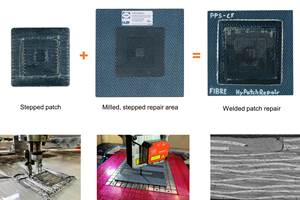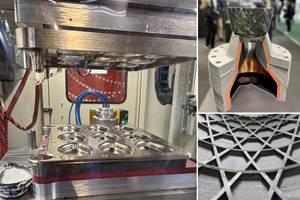Covestro and EconCore collaborate on FST-optimized honeycomb core and panels
The collaboration aims to optimize the FST performance of honeycomb panels for public transportation applications, including railway and aerospace.
Covestro (Leverkusen, Germany) and EconCore N.V. (Leuven, Belgium) have announced a joint collaboration on development of strong and lightweight honeycomb panels that comply with Fire, Smoke, Toxicity (FST) requirements for public transportation applications, including railway and aerospace.
Covestro has developed and tested a wide range of polycarbonates and blends with specific grades to meet the FST performance required by railway and aviation applications. Furthermore, the company is currently developing a range of lightweight thermoplastic composite solutions under the brand name Maezio. EconCore has developed and patented a unique manufacturing process to produce ultra-light honeycomb structures in an economic way, with a variety of material combinations that can be fine-tuned to meet customers’ needs.
The collaboration between the companies aims to optimize the FST performance of honeycomb panels in order to meet different application requirements. The JV’s approach is to select the right combination of polycarbonate grades and composites for the honeycomb core and skin, while simultaneously adapting the parameters within EconCore’s honeycomb technology.
During preliminary FST tests, carried out by an independent institute on semi-finished, laminated honeycomb panels, sandwich-panels with different material and technology combinations were produced and evaluated. The panels fulfilled critical tests of EN45545 or FAR25.853 standards for various applications. The results of the preliminary FST tests are currently being verified in detailed investigations of different material combinations.
The ultimate goal of the collaboration is to provide sandwich panels that fulfill the technical requirements, offer weight advantages and offer cost savings compared with currently used composite or metal solutions. EconCore’s patented manufacturing process offers cost saving potential due to a high-speed and fully integrated continuous production process, where thermoplastic polymers are directly converted into a honeycomb structure and the sandwich skin layers can be immediately laminated onto core.
“The outstanding manufacturing process of EconCore allows tailoring our materials into lightweight sandwich panel solutions for our customers,” says Klaus Kraner, responsible for mass transportation applications in the Polycarbonates segment at Covestro.
“The sandwich technology of EconCore is especially interesting for lightweight applications Covestro is targeting with Maezio,” adds Arne Böttcher, responsible for market development of the Maezio brand in the EMEA region.
“After succeeding in other application domains, we have decided to address inquiries of the higher end markets. The process has been proven to work very well with a wide range of thermoplastic materials, including these with FST chemistry, while EconCore’s technology has demonstrated its capability of delivering high-performance sandwich panels at high efficiency and cost levels not achievable with conventional methods,” says Tomasz Czarnecki, COO of EconCore N.V.
Czarnecki adds, “We look forward to this new development and to continuing the partnership with Covestro. The polycarbonate-portfolio of our partner, combined with the composite solutions of Maezio, provides us with the variety and quality of materials needed to meet the high technical requirements in mass-transportation markets. This journey is not only about making thermoplastic honeycomb cores. Imagine the potential benefits for the aerospace industry, if it had the option to thermoform sandwich panels into finished parts in a one-shot operation. The industry, already inclining to monolithic thermoplastic composites, has not seen such a change for decades.”
Covestro (booth no. L5/H5) and EconCore (booth no. R83/H6) will be exhibiting at JEC World 2019, Mar. 12-14.
Related Content
Welding is not bonding
Discussion of the issues in our understanding of thermoplastic composite welded structures and certification of the latest materials and welding technologies for future airframes.
Read MoreDeveloping repairs for thermoplastic composite aerostructures
HyPatchRepair project proves feasibility of automated process chain for welded thermoplastic composite patch repairs.
Read MoreJEC World 2024 highlights: Thermoplastic composites, CMC and novel processes
CW senior technical editor Ginger Gardiner discusses some of the developments and demonstrators shown at the industry’s largest composites exhibition and conference.
Read MorePlant tour: Joby Aviation, Marina, Calif., U.S.
As the advanced air mobility market begins to take shape, market leader Joby Aviation works to industrialize composites manufacturing for its first-generation, composites-intensive, all-electric air taxi.
Read MoreRead Next
All-recycled, needle-punched nonwoven CFRP slashes carbon footprint of Formula 2 seat
Dallara and Tenowo collaborate to produce a race-ready Formula 2 seat using recycled carbon fiber, reducing CO2 emissions by 97.5% compared to virgin materials.
Read MoreDeveloping bonded composite repair for ships, offshore units
Bureau Veritas and industry partners issue guidelines and pave the way for certification via StrengthBond Offshore project.
Read More“Structured air” TPS safeguards composite structures
Powered by an 85% air/15% pure polyimide aerogel, Blueshift’s novel material system protects structures during transient thermal events from -200°C to beyond 2400°C for rockets, battery boxes and more.
Read More


























